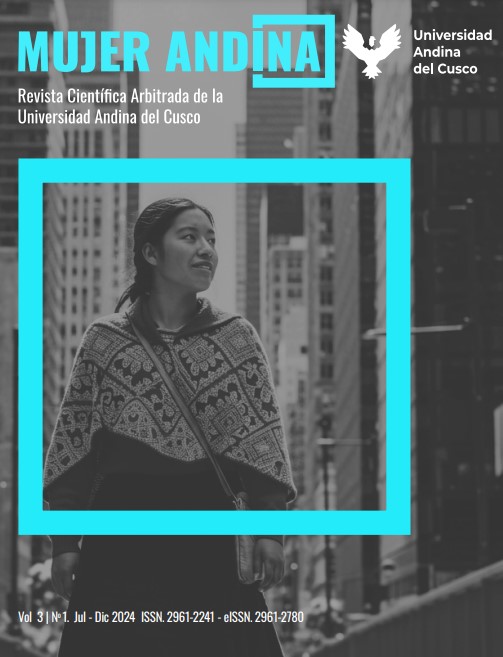Aproximaciones sobre la violencia doméstica en las mujeres indígenas del municipio de Jambaló en Cauca
DOI:
https://doi.org/10.36881/ma.v3i1.948Palabras clave:
Creencias, estrategias de afrontamiento, violencia doméstica, mujeres indígenas, modelo ecológicoResumen
A partir de la década de los setenta, varias organizaciones no gubernamentales y entidades internacionales comenzaron a destacar la importancia de garantizar el respeto por los derechos de las mujeres; sin embargo, han sido pocas las investigaciones que se han realizado para analizar esta problemática y qué estrategias se han venido incorporando para su atención; con base en ello, buscando caracterizar las creencias y estrategias de afrontamiento en mujeres indígenas que han sufrido de violencia doméstica, se fija como objetivo definir algunas aproximaciones sobre la violencia doméstica en mujeres indígenas del municipio de Jambaló en Cauca, utilizando los fundamentos teóricos de Delgado-Castillo, et al., (2021); Méndez, et al., (2022); entre otros; con un diseño etnometodológico, desde un enfoque cualitativo y la técnica de entrevista en profundidad. Las participantes fueron 11 indígenas Nasa (mujeres) que habitan en el municipio de Jambaló en Cauca y aceptaron participar en la investigación. Algunas de las categorías analizadas fueron las estrategias de afrontamiento utilizadas por las indígenas para hacer frente a la violencia, además de las creencias que se tienen sobre este fenómeno. Se obtuvo como resultado que las mujeres manifestaron sentirse cansadas y asustadas por la repetición de los actos violentos hacia ellas, por lo cual decidieron abandonar sus creencias culturales y explorar diversas estrategias de afrontamiento orientadas a la acción. Concluyendo que el municipio de Jambaló se encuentra bajo una cultura patriarcal y de dominación del hombre sobre la mujer, quien ha naturalizado la violencia en esta comunidad indígena, sin embargo, las creencias sobre el maltrato no son rígidas y han permitido el surgimiento de nuevas estrategias que les permitieron cortar el ciclo de violencia al que estaban acostumbradas.
Descargas
Citas
Antoniou, E., & Iatrakis, G. (2019). Domestic violence during pregnancy in greece. International Journal of Environmental. Research and Public Health, 16(21) https://doi.org/10.3390/ijerph16214222
Anyemedu, A., Tenkorang, E. Y., & Dold, P. (2020). Ghanaian Women’s knowledge and perceptions of services available to victims of intimate partner violence. Journal of Interpersonal Violence, 35(3-4), 682-706. https://doi.org/10.1177/0886260517689886
Arora, S., Deosthali, P. B., & Rege, S. (2019). Effectiveness of a counselling intervention implemented in antenatal setting for pregnant women facing domestic violence: A pre-experimental study. BJOG: An International Journal of Obstetrics and Gynaecology, 126(S4), 50-57. https://doi.org/10.1111/1471-0528.15846
Aslan, E., Bodur, G., Beji, N. K., Alkan, N., & Aksoy, Ö. (2019). Exposure to domestic violence in women living in istanbul and aegean regions: A turkish sample. [Exposição à violência doméstica em mulheres que vivem em istambul e nas regiões do egeu: Uma amostra turca]. Ciencia e Saude Coletiva, 24(8), 2835-2844. https://doi.org/10.1590/1413-81232018248.22952017
Both, L. M., Favaretto, T. C., & Freitas, L. H. M. (2019). Cycle of violence in women victims of domestic violence: Qualitative analysis of OPD 2 interview. Brain and Behavior. 9(11) https://doi.org/10.1002/brb3.1430
Bronfenbrenner, U. (1987). La ecología del desarrollo humano: Experimentos en entornos naturales y diseñados. http://psicopedagogosrioiv.com.ar/wordpress%20colegio/wp-content/uploads/2017/07/la-ecologia-del-desarrollo-humano-bronfenbrenner-copia.pdf
Carneiro, J. B., Gomes, N. P., Campos, L. M., da Silva, A. F., da Cunha, K. S., & Da Costa, D. M. D. S. C. (2019). Understanding marital violence: A study in grounded theory. [Compreendendo a violência conjugal: Um estudo em grounded theory; Comprendiendo la violencia conyugal: Un estudio en grounded theory]. Revista Latino-Americana De Enfermagem, 27. https://doi.org/10.1590/1518-8345.3116.3185
Chuemchit, M., Chernkwanma, S., Somrongthong, R y Spitzer, D. (2018). Thai women’s experiences of and responses to domestic violence. International journal of women´s health, 10. 557-565. https://doi.org/10.2147/IJWH.S172870
Clark, C. J., Cheong, Y. F., Gupta, J., Ferguson, G., Shrestha, B., Shrestha, P. N., & Yount, K. M. (2019). Intimate partner violence in nepal: Latent patterns and association with depressive symptoms. SSM - Population Health, 9 https://doi.org/10.1016/j.ssmph.2019.100481
Córdova, K; Terven, A. (2022). La violencia sin huella. Un estudio sobre los estereotipos femeninos y de la violencia como obstáculos en la judicialización de denuncias en Querétaro, México. Revista Humanidades, 12(1), 2-17. https://www.redalyc.org/articulo.oa?id=498068490004
De Castro Bhona, F. M., De Paula Gebara, C. F., Noto, A. R., De Toledo Vieira, M., & Lourenço, L. M. (2019). Socioeconomic factors and intimate partner violence: A household survey. Trends in Psychology, 27(1), 205-218. https://doi.org/10.9788/TP2019.1-15
De Oliveira, B. M., de Lucena, K. D. T., Gomes, R. G. S., Coêlho, H. F. C., Vianna, R. P. T., & Meira, R. M. B. (2019). Spatial distribution of domestic violence against women. [Distribuição espacial da violência doméstica contra a mulher]. Journal of Human Growth and Development, 29(1), 102-109. https://doi.org/10.7322/jhgd.152305
Delgado-Castillo, G; Lip-Licham, C y Martínez-López E. (2021). Aprendizaje intergeneracional de la violencia familiar: experiencias de vida. Digital Publisher, 6(4-1), 127-139.
Eldoseri, H. M., & Sharps, P. (2020). Risk factors for spousal physical violence against women in saudi arabia. Journal of Interpersonal Violence, 35(5-6), 1269-1293. https://doi.org/10.1177/0886260517696861
Eng, S., Grace, K., & Szmodis, W. (2020). Parenting practices and child mortality in Remarried/Repartnered families in cambodia. Journal of Family Issues, 41(7), 1010-1032. https://doi.org/10.1177/0192513X20918431
Fagbamigbe, A. F., Akintayo, A. O., Oshodi, O. C., Makinde, F. T., Babalola, M., Araoye, E. D., Dairo, M. D. (2020). Survival analysis and prognostic factors of time to first domestic violence after marriage among nigeria, kenya, and mozambique women. Public Health, 181, 122-134. https://doi.org/10.1016/j.puhe.2019.12.003
Gadd, D., Henderson, J., Radcliffe, P., Stephens-Lewis, D., Johnson, A., & Gilchrist, G. (2019). The dynamics of domestic abuse and drug and alcohol dependency. British Journal of Criminology, 59(5), 1035-1053. https://doi.org/10.1093/bjc/azz011
Hawcroft, C; Hughes, R; Shaheen, A y Usta, J (2019). Prevalence and health outcomes of domestic violence amongst clinical populations in Arab countries: A systematic review and meta-analysis. BMC Public Health, 19. https://doi.org/10.1186/s12889-019-6619-2
Hoepers, A. D., & Tomanik, E. A. (2019). Constructing meanings: The group as a device for facing domestic violence against women. [construindo sentidos: O grupo como dispositivo de enfrentamento à violência doméstica contra as mulheres]. Psicologia e Sociedade, 31. https://doi.org/10.1590/1807-0310/2019V31214338
López, M; Montes-Berges, B; Castillo-Mayén, M; Higueras, M. (2014). Percepción de la segunda victimización en violencia de género. Escritos de Psicología- Psychological Writings, 7(2), 11-18. https://www.redalyc.org/pdf/2710/271031689002.pdf
Macedo, P., Miura P., Barrientos D., Lopes G. & Egry E. (2018). Coping strategies for domestic violence against pregnant female adolescents: integrative review. Rev. Bras Enferm. 71, 693-699. https://doi.org/10.1590/0034-7167-2017-0682
Macías, M., Madariaga, C., Valle, M. y Zambrano, J. (2013). Estrategias de afrontamiento individual y familiar frente a situaciones de estrés psicológico. Psicología desde el Caribe, 30(1). http://rcientificas.uninorte.edu.co/index.php/psicologia/article/view/2051/6906
Martínez, A. (2016). La violencia. Conceptualización y elementos para su estudio. Política y cultura, (46), 7-31. https://www.redalyc.org/articulo.oa?id=26748252001
Méndez, M. del P., Barragán, A.., Peñaloza, R., & García, M. (2022). Severidad de la violencia de pareja y reacciones emocionales en mujeres. Psicumex, 12(1), 1–20. https://doi.org/10.36793/psicumex.v12i1.400
Mugoya, G. C. T., Witte, T., Bolland, A., Tomek, S., Hooper, L. M., Bolland, J., & George Dalmida, S. (2020). Depression and intimate partner violence among african american women living in impoverished inner-city neighborhoods. Journal of Interpersonal Violence, 35(3-4), 899-923. https://doi.org/10.1177/0886260517691519
Organización Mundial de la Salud. (2019). Respect Women: Preventing Violence Against Women.UN-W. https://apps.who.int/iris/bitstream/handle/10665/312261/WHO-RHR-18.19-eng.pdf
Organización Panamericana de la Salud, Oficina Sanitaria Panamericana y Organización Mundial de la salud. (2003). Informe mundial sobre la violencia y la salud. (Número 588). http://apps.who.int/iris/bitstream/10665/112670/1/9275315884_spa.pdf
Organización Panamericana de la Salud. (2013). Consecuencias para la salud. En Comprender y abordar la violencia contra las mujeres. (pp. 01‐08). Washington, DC. : OPS. http://apps.who.int/iris/bitstream/10665/98862/1/WHO_RHR_12.43_spa.pdf
Palop, M. (2019). El concepto y el ciclo de la violencia de género en las relaciones de pareja de menores offline y online. Anuario Da Facultade De Dereito Da Universidade Da Coruña. 22, 188-213. https://doi.org/10.17979/afdudc.2018.22.0.5183
Pitt, K., Dheensa, S., Feder, G. et al. (2020). Sharing reports about domestic violence and abuse with general practitioners: a qualitative interview study. BMC Fam Pract 21, 117. https://doi.org/10.1186/s12875-020-01171-4
Putra, I.G.N.E., Pradnyani, P.E. and Parwangsa, N.W.P.L. (2019). Vulnerability to domestic physical violence among married women in Indonesia. Journal of Health Research, 33(2), pp. 90-105. https://doi.org/10.1108/JHR-06-2018-0018
Rahebi SM; Rahnavardi M; Rezaie-Chamani S; Nazari M; Sabetghadam S. (2019). Relationship between domestic violence and infertility. East Mediterr Health J, 25(8), 537-542. https://doi.org/10.26719/emhj.19.001
Ram, A., Victor, C., Christy, H., Hembrom, S., Cherian, A., & Mohan, V. (2019). Domestic violence and its determinants among 15-49-year-old women in a rural block in south India. Indian Journal of Community Medicine, 44(4), 362-367. https://doi.org/10.4103/ijcm.IJCM_84_19
Reif, K., Jaffe, P., Dawson, M., & Straatman, A. (2020). Provision of specialized services for children exposed to domestic violence: Barriers encountered in violence against women (VAW) services. Children and Youth Services Review, 109 https://doi.org/10.1016/j.childyouth.2019.104684
Rezey, M. L. (2020). Separated Women’s risk for intimate partner violence: A multiyear analysis using the national crime victimization survey. Journal of Interpersonal Violence, 35(5-6), 1055-1080. https://doi.org/10.1177/0886260517692334
Rodríguez, G., Gil, J. y García, E. (1996). Introducción a la investigación cualitativa. Metodología de la investigación cualitativa (pp. 01 37). Aljibe. https://www.researchgate.net/publication/44376485_Metodologia_de_la_investigacion_cualitativa_Gregorio_Rodriguez_Gomez_Javier_Gil_Flores_Eduardo_Garcia_Jimenez
Rodríguez, R., Riosvelasco, L., & Castillo, N. (2018). Violencia en el noviazgo, género y apoyo social en jóvenes universitarios. Escritos de psicología, 11(1), 1-9. https://doi.org/10.5231/psy.writ.2018.2203
Sattarzadeh, N., Farshbaf-Khalili, A., & Hatamian-Maleki, T. (2019). An evidence-based glance at domestic violence phenomenon in early marriages: A narrative review. International Journal of Women's Health and Reproduction Sciences, 7(3), 246-254. https://doi.org/10.15296/ijwhr.2019.42
Shaari, M. S., Yahaya, M. H., & Juaini, N. J. M. (2019). Understanding the communication pattern and emotional abuse:Domestic violence victims among married women. International Journal of Recent Technology and Engineering, 8(2 Special Issue 3), 246-250. https://doi.org/10.35940/ijrte.B1042.0782S319
Spangaro, J., Vajda, J., Klineberg, E., Lin, S., Griffiths, C., Saberi, E., McNamara, L. (2020). Intimate partner violence screening and response in new south wales emergency departments: A multi-site feasibility study. EMA - Emergency Medicine Australasia, 32(4), 548-555. https://doi.org/10.1111/1742-6723.13452
Spapens, T & Moors, H (2020). Intergenerational transmission and organised crime. A study of seven families in the south of the Netherlands. Trends in Organized Crime 23(2), 227-241. https://doi.org/10.1007/s12117-019-09363-w
Sunmola, A. M., Mayungbo, O. A., Ashefor, G. A., & Morakinyo, L. A. (2020). Does relation between women’s justification of wife beating and intimate partner violence differ in context of husband’s controlling attitudes in Nigeria? Journal of Family Issues, 41(1), 85–108. https://doi.org/10.1177/0192513X19868831
Wali, R., Khalil, A., Alattas, R. et al. (2020). Prevalence and risk factors of domestic violence in women attending the National Guard Primary Health Care Centers in the Western Region, Saudi Arabia, 2018. BMC Public Health, 20, 239. https://doi.org/10.1186/s12889-020-8156-4
Descargas
Publicado
Cómo citar
Número
Sección
Categorías
Licencia

Esta obra está bajo una licencia internacional Creative Commons Atribución 4.0.
El contenido de las publicaciones es responsabilidad de los autores. La revista permite a los autores mantener los derechos de autor sobre los artículos y documentos publicados. La licencia usada es Commons Reconocimiento -No Comercial Internacional License. CC BY

















